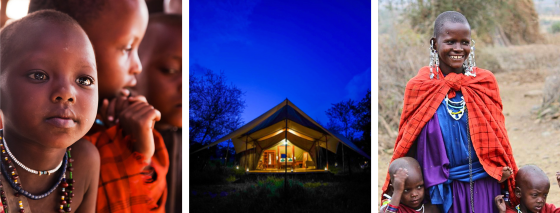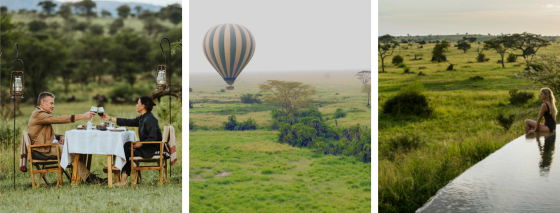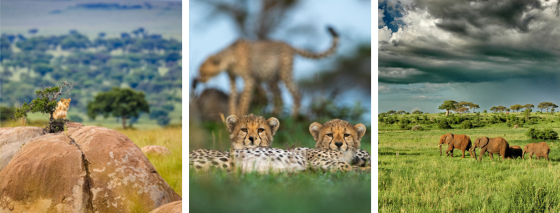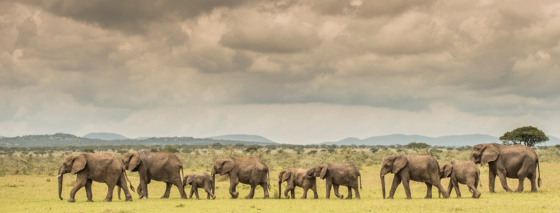6 Reasons to Visit East Africa during the Green Season
Lanky legs and large, curious eyes are some of the characteristics that make wildebeest calves so endearing. Unlike the adults that grunt, snort and trundle across the Serengeti in droves, heads down, one hoof step at a time. Despite not being the most beautiful of animals, the sheer number of wildebeest has long been a drawcard to the Serengeti, particularly during the peak safari season of July to October. However, many travellers don’t realise that the Great Migration is not limited to those four months. The wildebeest move vaguely circularly, constantly following the rains and flourishing grass. You may have a better safari experience during the green season (November to May). Here are some compelling reasons to visit East Africa when the region is transformed into a lush, vibrant landscape.
1. Ideal conditions for photography and bird watching
While there isn’t a single best time for wildlife photography in Tanzania, the vibrant landscapes and nearly constant billowing clouds during the green season create ideal atmospheric conditions. Whether you aim to capture wildlife against dramatic backdrops or take rich, moody landscape shots, this time of year is perfect. The green season offers incredible photographic opportunities, from newborn calves skipping across the plains to rain-soaked sunsets.
The green season isn’t just about mammals — it’s also a birder’s paradise. Certain parks host up to 500 bird species, and up to 200 migratory bird species flock to East Africa during this time, filling the skies and wetlands with vibrant colours and melodic calls. The parks of Nyerere and Ruaha see a spike in bird populations, with many species showing off their breeding plumage. Migratory birds like the Caspian lapwing, European bee-eater, pallid harrier and lesser kestrel are among those that can be spotted. Even if you’re not a dedicated birdwatcher, the sheer variety and beauty of the birds are captivating.

2. Witness calving and predator interactions
While safari-goers often aim for the dry season, believing wildlife is easier to spot near scarce water sources, the green season brings a unique magic. With abundant food and water, many animals give birth during this time. In the Ngorongoro Conservation Area and southern Serengeti, over 80% of female wildebeest give birth between late January and mid-March, with about 8,000 calves born daily. The abundance of life draws predators, and wildlife activity can be particularly dynamic.
You might witness a majestic black-maned lion in full stalk mode, his front shoulders low to the ground as he moves stealthily across the plain, causing zebras and wildebeest to scatter if they catch sight of him. Or, take in the captivating sight of flocks of pink flamingos congregating on the shimmering waters of the Empakaai Crater, their distinct nasal honking filling the air. The lush landscape also draws large troops of baboons, from big-fanged males who confidently strut past your game vehicle to bumbling babies that topple over their limbs.

3. Positive community impact
Tourism is a vital source of income for many communities across East Africa, creating jobs and fuelling local economies. In the green season, when fewer tourists visit, money spent on accommodation, guides, and local goods supports these communities directly. This steady flow of income during off-peak months helps sustain livelihoods that depend on tourism year-round and fosters a more sustainable and balanced approach to tourism.
4. Wildlife and habitat protection
Travelling in the green season helps mitigate the environmental pressures that can impact wildlife and ecosystems during peak periods. Many of East Africa’s most popular safari destinations experience intense visitor numbers during popular travel periods, putting pressure on wildlife, habitats, and local resources. By visiting during the green season, you can enjoy a more intimate experience and support community development initiatives, from education and healthcare to conservation programs that benefit the region’s people and wildlife.

5. Flexibility and better rates
Finding last-minute availability during the high season can be a struggle. But travelling during the green season could provide you with more flexibility. Accommodation that might be fully booked in peak season is more accessible, allowing for a broader range of choices to customise your itinerary. Whether it’s a luxury lodge in Northern Tanzania or a private guide in the Serengeti, you have more freedom to craft your ideal safari experience.
While cost isn’t always a determining factor, many safari lodges offer substantial discounts during the green season. This means you can enjoy luxury for less or extend your stay for longer, and these savings don’t compromise the quality of the experience.

6. Fewer visitors allow for more intimate experiences
Peak season in the Serengeti and Masai Mara can conjure images of groups of game vehicles filled with eager tourists descending on kill sights or crowding at the riverbanks in the hope of seeing wildebeest river crossing. While witnessing the river crossings, which occur during peak season, can be enthralling, there’s also the reality of seeing crocodiles feast during the frenetic rush. However, the green season provides a more tranquil experience with fewer visitors. You might find you’re on the only game vehicle watching a lion, leopard, or cheetah on the prowl. You could also enjoy a more meaningful interaction with local communities, who will have more time to engage with visitors during this time.
Happy travelling,
The Leopard Team
P.S. We’d love to share more with you as you consider the pros and cons of a fly-in versus a drive-in safari or which season (whether green or not) will suit you best. Click the ‘Start Planning Here’ button (top right) if you’d like us to help you design a personalised East African safari itinerary tailored perfectly to your preferences.

Sign up for more newsletters like this here: https://mailchi.mp/2e4afa50d15f/leopard


